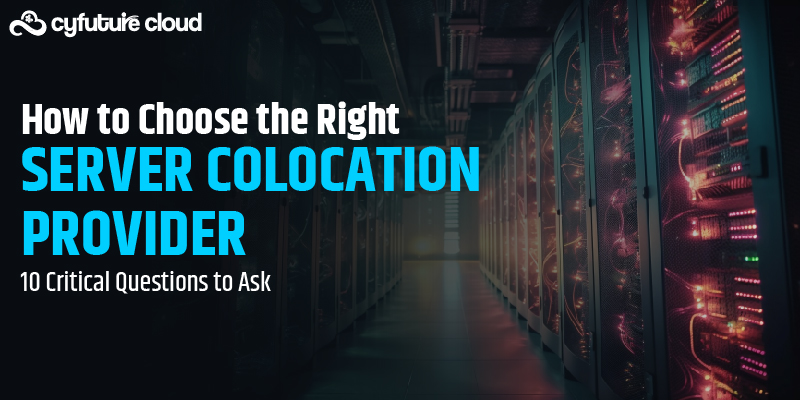Get 69% Off on Cloud Hosting : Claim Your Offer Now!
- Products
-
Compute
Compute
- Predefined TemplatesChoose from a library of predefined templates to deploy virtual machines!
- Custom TemplatesUse Cyfuture Cloud custom templates to create new VMs in a cloud computing environment
- Spot Machines/ Machines on Flex ModelAffordable compute instances suitable for batch jobs and fault-tolerant workloads.
- Shielded ComputingProtect enterprise workloads from threats like remote attacks, privilege escalation, and malicious insiders with Shielded Computing
- GPU CloudGet access to graphics processing units (GPUs) through a Cyfuture cloud infrastructure
- vAppsHost applications and services, or create a test or development environment with Cyfuture Cloud vApps, powered by VMware
- Serverless ComputingNo need to worry about provisioning or managing servers, switch to Serverless Computing with Cyfuture Cloud
- HPCHigh-Performance Computing
- BaremetalBare metal refers to a type of cloud computing service that provides access to dedicated physical servers, rather than virtualized servers.
-
Storage
Storage
- Standard StorageGet access to low-latency access to data and a high level of reliability with Cyfuture Cloud standard storage service
- Nearline StorageStore data at a lower cost without compromising on the level of availability with Nearline
- Coldline StorageStore infrequently used data at low cost with Cyfuture Cloud coldline storage
- Archival StorageStore data in a long-term, durable manner with Cyfuture Cloud archival storage service
-
Database
Database
- MS SQLStore and manage a wide range of applications with Cyfuture Cloud MS SQL
- MariaDBStore and manage data with the cloud with enhanced speed and reliability
- MongoDBNow, store and manage large amounts of data in the cloud with Cyfuture Cloud MongoDB
- Redis CacheStore and retrieve large amounts of data quickly with Cyfuture Cloud Redis Cache
-
Automation
Automation
-
Containers
Containers
- KubernetesNow deploy and manage your applications more efficiently and effectively with the Cyfuture Cloud Kubernetes service
- MicroservicesDesign a cloud application that is multilingual, easily scalable, easy to maintain and deploy, highly available, and minimizes failures using Cyfuture Cloud microservices
-
Operations
Operations
- Real-time Monitoring & Logging ServicesMonitor & track the performance of your applications with real-time monitoring & logging services offered by Cyfuture Cloud
- Infra-maintenance & OptimizationEnsure that your organization is functioning properly with Cyfuture Cloud
- Application Performance ServiceOptimize the performance of your applications over cloud with us
- Database Performance ServiceOptimize the performance of databases over the cloud with us
- Security Managed ServiceProtect your systems and data from security threats with us!
- Back-up As a ServiceStore and manage backups of data in the cloud with Cyfuture Cloud Backup as a Service
- Data Back-up & RestoreStore and manage backups of your data in the cloud with us
- Remote Back-upStore and manage backups in the cloud with remote backup service with Cyfuture Cloud
- Disaster RecoveryStore copies of your data and applications in the cloud and use them to recover in the event of a disaster with the disaster recovery service offered by us
-
Networking
Networking
- Load BalancerEnsure that applications deployed across cloud environments are available, secure, and responsive with an easy, modern approach to load balancing
- Virtual Data CenterNo need to build and maintain a physical data center. It’s time for the virtual data center
- Private LinkPrivate Link is a service offered by Cyfuture Cloud that enables businesses to securely connect their on-premises network to Cyfuture Cloud's network over a private network connection
- Private CircuitGain a high level of security and privacy with private circuits
- VPN GatewaySecurely connect your on-premises network to our network over the internet with VPN Gateway
- CDNGet high availability and performance by distributing the service spatially relative to end users with CDN
-
Media
-
Analytics
Analytics
-
Security
Security
-
Network Firewall
- DNATTranslate destination IP address when connecting from public IP address to a private IP address with DNAT
- SNATWith SNAT, allow traffic from a private network to go to the internet
- WAFProtect your applications from any malicious activity with Cyfuture Cloud WAF service
- DDoSSave your organization from DoSS attacks with Cyfuture Cloud
- IPS/ IDSMonitor and prevent your cloud-based network & infrastructure with IPS/ IDS service by Cyfuture Cloud
- Anti-Virus & Anti-MalwareProtect your cloud-based network & infrastructure with antivirus and antimalware services by Cyfuture Cloud
- Threat EmulationTest the effectiveness of cloud security system with Cyfuture Cloud threat emulation service
- SIEM & SOARMonitor and respond to security threats with SIEM & SOAR services offered by Cyfuture Cloud
- Multi-Factor AuthenticationNow provide an additional layer of security to prevent unauthorized users from accessing your cloud account, even when the password has been stolen!
- SSLSecure data transmission over web browsers with SSL service offered by Cyfuture Cloud
- Threat Detection/ Zero DayThreat detection and zero-day protection are security features that are offered by Cyfuture Cloud as a part of its security offerings
- Vulnerability AssesmentIdentify and analyze vulnerabilities and weaknesses with the Vulnerability Assessment service offered by Cyfuture Cloud
- Penetration TestingIdentify and analyze vulnerabilities and weaknesses with the Penetration Testing service offered by Cyfuture Cloud
- Cloud Key ManagementSecure storage, management, and use of cryptographic keys within a cloud environment with Cloud Key Management
- Cloud Security Posture Management serviceWith Cyfuture Cloud, you get continuous cloud security improvements and adaptations to reduce the chances of successful attacks
- Managed HSMProtect sensitive data and meet regulatory requirements for secure data storage and processing.
- Zero TrustEnsure complete security of network connections and devices over the cloud with Zero Trust Service
- IdentityManage and control access to their network resources and applications for your business with Identity service by Cyfuture Cloud
-
-
Compute
- Solutions
-
Solutions
Solutions
-
 Cloud
Hosting
Cloud
Hosting
-
 VPS
Hosting
VPS
Hosting
-
GPU Cloud
-
 Dedicated
Server
Dedicated
Server
-
 Server
Colocation
Server
Colocation
-
 Backup as a Service
Backup as a Service
-
 CDN
Network
CDN
Network
-
 Window
Cloud Hosting
Window
Cloud Hosting
-
 Linux
Cloud Hosting
Linux
Cloud Hosting
-
Managed Cloud Service
-
Storage as a Service
-
 VMware
Public Cloud
VMware
Public Cloud
-
 Multi-Cloud
Hosting
Multi-Cloud
Hosting
-
 Cloud
Server Hosting
Cloud
Server Hosting
-
 Bare
Metal Server
Bare
Metal Server
-
 Virtual
Machine
Virtual
Machine
-
 Magento
Hosting
Magento
Hosting
-
Remote Backup
-
 DevOps
DevOps
-
 Kubernetes
Kubernetes
-
 Cloud
Storage
Cloud
Storage
-
NVMe Hosting
-
 DR
as s Service
DR
as s Service
-
-
Solutions
- Marketplace
- Pricing
- Resources
- Resources
-
By Product
Use Cases
-
By Industry
- Company
-
Company
Company
-
Company
What is Cloud Computing?- The 2022 Edition
Table of Contents
- What is Cloud Computing?
- Cloud computing services available in India
- What are some illustrations of cloud computing?
- What does “cloud computing” mean exactly?
- How significant is a cloud?
- Infrastructure as a Service: What is it?
- Platform as a Service: What is it?
- Software as a Service: What is it?
- What is computing on several clouds?
- What advantages does cloud computing offer?
- What are cloud computing’s benefits and drawbacks?
- What is the cloud computing industry’s future?
Whether you are starting your very own business or looking for a less cost computing service for your old one- it is always fair to understand What is cloud computing? It is a good practice to move up from down after completing the homework- in this case, it is all about Cloud computing.
Read further to know what cloud computing is. Also, get your hands on IaaS, PaaS, Hybrid, Public, and private cloud.
What is Cloud Computing?
Delivering computing services such as servers, storage, databases, networking, software, analytics, and intelligence over the internet/ cloud for faster innovation, flexible resources, and scale economies are called Cloud Computing.
How is cloud computing implemented?
Companies can access anything from programs to storage from a cloud service provider, renting access to them rather than owning their own computing equipment or data centers.
Utilizing cloud computing services allows businesses to bypass the upfront costs and complexity of purchasing and maintaining their own IT infrastructure in favor of paying only for the services they actually use. By offering the same services to a wide range of consumers, cloud computing service companies can gain enormous economies of scale.
Cloud computing services available in India
Cloud computing services today offer a wide range of possibilities, from the fundamentals of storage, networking, and processing power to advanced technologies like artificial intelligence and natural language processing as well as common office software. Even quantum computing can now be provided via the cloud, along with just about any other service that doesn’t require you to be physically adjacent to the computer gear you are utilizing.
What are some illustrations of cloud computing?
Cloud computing is the foundation of a huge variety of services. This ranges from services that let big businesses host all of their data and operate all of their apps in the cloud to consumer services like Gmail or the cloud backup of the images on your smartphone. For instance, Netflix uses cloud computing services to power both its video streaming platform and other internal business systems.
As software providers aim to transition to a subscription model, they are increasingly delivering their applications as services through the internet rather than separate goods, making cloud computing the default choice for many apps.
What does “cloud computing” mean exactly?
The location of the service and many other variables, such as the hardware or operating system on which it is running, are key ideas in cloud computing, although they are mostly irrelevant to the user. The public telephone network (and later the internet) were frequently depicted as clouds in ancient telecoms network diagrams to indicate that the location didn’t matter — it was just a cloud of things. With this in mind, the metaphor of the cloud was derived from these schematics. Of course, this oversimplifies the situation; for many consumers, the location of their services and data continues to be a major concern.
How significant is a cloud?
As computing workloads continue to migrate to the cloud, whether that be through the use of public cloud services provided by vendors or private clouds created by businesses themselves, a sizeable portion of all IT spending is now going toward building the infrastructure to support cloud computing, while spending on conventional, in-house IT is declining.
According to tech analyst Gartner, by 2025, up from 41% in 2022, up to 50% of investment in the application software, infrastructure software, business process services, and system infrastructure industries would have moved to the cloud. It predicts that by 2022, cloud computing would account for over two-thirds of application software spending, up from 57.7% in the previous year.
Infrastructure as a Service: What is it?
Physical or virtual servers, storage, and networking are the three basic components of computing that can be hired under the term “Infrastructure as a Service” (IaaS). This is appealing to businesses that want to create applications from the ground up and take almost complete control of the process; however, it does necessitate that businesses have the technical know-how necessary to coordinate services at that level.
Platform as a Service: What is it?
The next layer up is called Platform as a Service (PaaS), and it includes virtual servers, storage, networking, middleware, database management, operating systems, and development tools, among other things. This layer also includes the software and tools that developers will need to build applications on top of it.
Software as a Service: What is it?
The delivery of programmes as a service is known as software as a service (SaaS), and is perhaps the aspect of cloud computing that most people are accustomed to on a daily basis. The end user, who will access the service through a web browser or app, is unconcerned about the underlying hardware and operating system; it is frequently purchased on a per-seat or per-user basis.
What is computing on several clouds?
While the major cloud vendors would be more than delighted to meet all of the computing requirements of their enterprise clients, more and more companies are seeking to distribute the workload across a number of suppliers. The growth of multi-cloud is the result of everything. This strategy includes both avoiding vendor lock-in (which might result in the high prices and rigidity that the cloud is sometimes touted to avoid) and finding the optimal combination of technologies available in the market.
What advantages does cloud computing offer?
The precise advantages will depend on the sort of cloud service utilised, but employing cloud services essentially frees businesses from having to purchase or manage their own computing infrastructure.
There is no need to purchase servers, maintain operating systems or applications, decommission outdated hardware or software, or dispose of it because the supplier will handle all of these tasks for you. It may make more sense to employ a cloud provider for common apps like email than to rely on internal resources.
Because businesses only pay for the resources they use, using cloud services enables them to move projects along faster and test ideas without time-consuming procurement processes and significant up-front expenditures. Advocates of the cloud frequently point to this idea of corporate agility as a major benefit. The ability to launch new services quickly and easily without the time and effort required for traditional IT procurement should make it simpler to launch new apps. Additionally, the elastic nature of the cloud makes it simpler to scale up a new application quickly if it proves to be really successful.
What are cloud computing’s benefits and drawbacks?
Just as renting is not always more cost-effective than buying over the long run, cloud computing is not always less expensive than traditional types of computing. It could be more cost-effective to provide computer resources internally if an application has a consistent and predictable need for them.
Some businesses might be hesitant to host private information in a service that is also used by competitors. If you switch to a SaaS application, you can find yourself using the same programmes as a competitor, which could make it difficult to gain a competitive edge if the programme is essential to your company’s operations.
While using a new cloud application may be simple, moving current data or apps to the cloud may be significantly more difficult and expensive. Additionally, it appears that there is currently somewhat of a skills gap in the cloud, with a specific shortage of personnel with DevOps and multi-cloud monitoring and administration expertise.
What is the cloud computing industry’s future?
When it comes to organisational IT spending, cloud computing is set to surpass more established methods of delivering software and services internally that have been used for decades. However, as businesses get more at ease with the concept of having their data somewhere else than a server in the basement, use of the cloud is only expected to increase. And now, rather than just concentrating on price, cloud computing suppliers are increasingly promoting cloud computing as an agent of digital change.
Recent Post

Stay Ahead of the Curve.
Join the Cloud Movement, today!
© Cyfuture, All rights reserved.
Send this to a friend

 Pricing
Calculator
Pricing
Calculator
 Power
Power
 Utilities
Utilities VMware
Private Cloud
VMware
Private Cloud VMware
on AWS
VMware
on AWS VMware
on Azure
VMware
on Azure Service
Level Agreement
Service
Level Agreement 


















